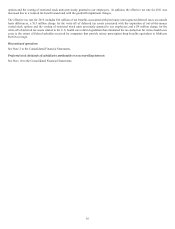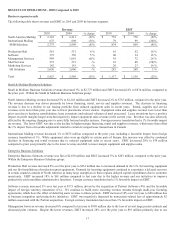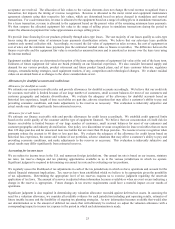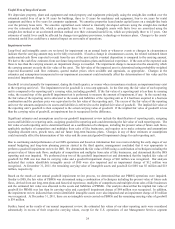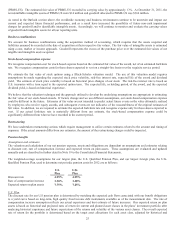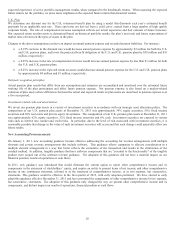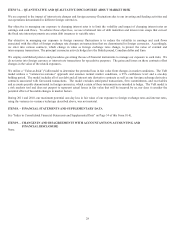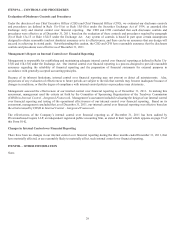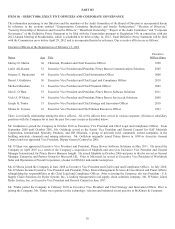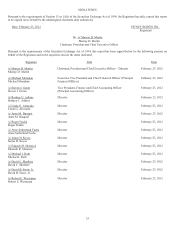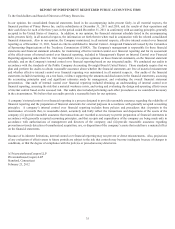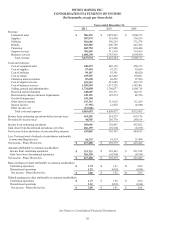Pitney Bowes 2011 Annual Report Download - page 44
Download and view the complete annual report
Please find page 44 of the 2011 Pitney Bowes annual report below. You can navigate through the pages in the report by either clicking on the pages listed below, or by using the keyword search tool below to find specific information within the annual report.
26
expected experience of active portfolio management results, when compared to the benchmark returns. When assessing the expected
future returns for the portfolio, we place more emphasis on the expected future returns than historical returns.
U.K. Plan
We determine our discount rate for the U.K. retirement benefit plan by using a model that discounts each year’s estimated benefit
payments by an applicable spot rate. These spot rates are derived from a yield curve created from a large number of high quality
corporate bonds. The rate of compensation increase assumption reflects our actual experience and best estimate of future increases.
Our expected return on plan assets is determined based on historical portfolio results, the plan’s asset mix and future expectations of
market rates of return on the types of assets in the plan.
Changes to the above assumptions can have an impact on annual pension expense and recorded pension liabilities. For instance:
• a 0.25% increase in the discount rate would decrease annual pension expense by approximately $2 million for both the U.S.
and U.K. pension plans, and lower the projected benefit obligation of the U.S. and U.K. pension plans by $38 million and $18
million, respectively;
• a 0.25% increase in the rate of compensation increase would increase annual pension expense by less than $1 million for both
the U.S. and U.K. pension plans;
• a 0.25% increase in the expected return on assets would decrease annual pension expense for the U.S. and U.K. pension plans
by approximately $4 million and $1 million, respectively.
Delayed recognition principles
Actual pension plan results that differ from our assumptions and estimates are accumulated and amortized over the estimated future
working life of the plan participants and affect future pension expense. Net pension expense is also based on a market-related
valuation of plan assets where differences between the actual and expected return on plan assets are amortized to pension expense over
a five-year period.
Investment related risks and uncertainties
We invest our pension plan assets in a variety of investment securities in accordance with our strategic asset allocation policy. The
composition of our U.S. pension plan assets at December 31, 2011 was approximately 34% equity securities, 56% fixed income
securities and 10% real estate and private equity investments. The composition of our U.K. pension plan assets at December 31, 2011
was approximately 62% equity securities, 32% fixed income securities and 6% cash. Investment securities are exposed to various
risks such as interest rate, market and credit risks. In particular, due to the level of risk associated with investment securities, it is
reasonably possible that change in the value of such investment securities will occur and that such change could materially affect our
future results.
New Accounting Pronouncements
On January 1, 2011, new accounting guidance became effective addressing the accounting for revenue arrangements with multiple
elements and certain revenue arrangements that include software. This guidance allows companies to allocate consideration in a
multiple element arrangement in a way that better reflects the economics of the transaction and results in the elimination of the
residual method. In addition, tangible products that have software components that are “essential to the functionality” of the tangible
product were scoped out of the software revenue guidance. The adoption of this guidance did not have a material impact on our
financial position, results of operations or cash flows.
In 2011, new guidance was introduced that would eliminate the current option to report other comprehensive income and its
components in the statement of stockholders’ equity, and require an entity to present items of net income and other comprehensive
income in one continuous statement, referred to as the statement of comprehensive income, or in two separate, but consecutive,
statements. This guidance would be effective in the first quarter of 2012, with early adoption permitted. We have elected to early
adopt this guidance effective December 31, 2011 and have presented the components of other comprehensive income in two separate,
but consecutive, statements. The adoption of this guidance only changed the way we present other comprehensive income and its
components, and did not impact our results of operations, financial position or cash flows.


